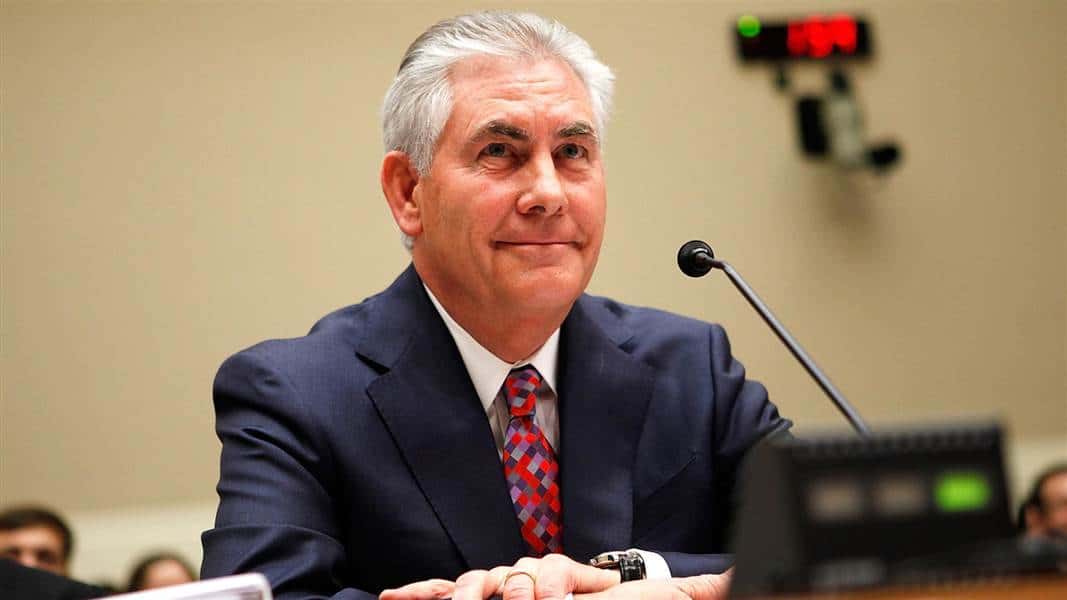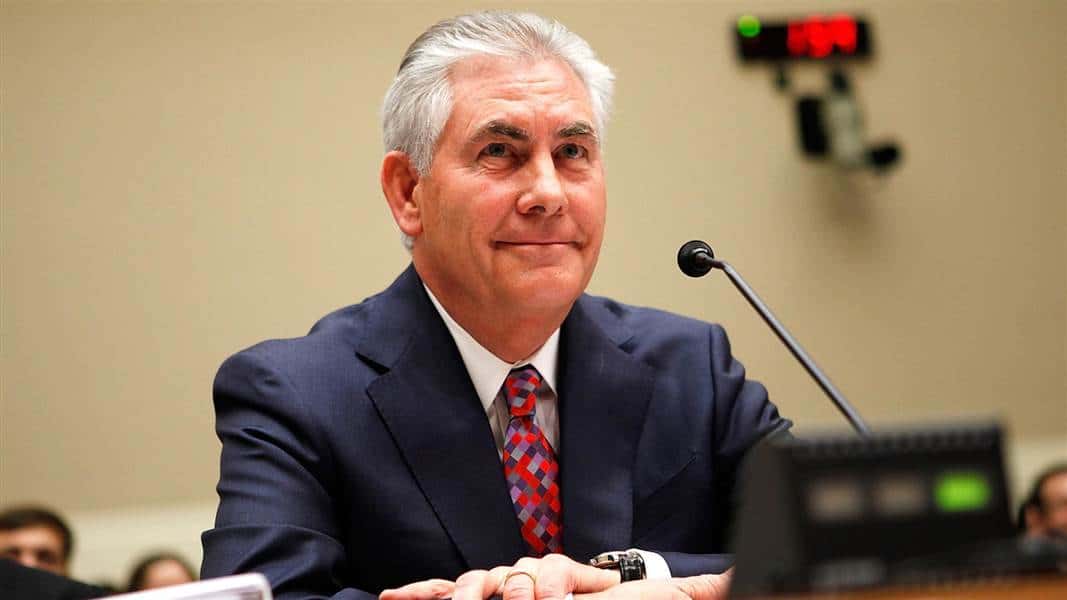
Some 1000 employees at the Department of State are said to have signed a formal memo sent through the “Dissent Channel” in late January, opposing President Donald Trump’s Executive Order initially blocking all Syrian refugee admissions indefinitely, delaying other refugees 120 days, prohibiting for 90 days all other travelers (diplomats excluded) from seven Muslim-majority nations, and other immigration-related issues.
What is the Dissent Channel those State employees used? What effect if any will the memo have on policy? What does the memo say to the new Secretary of State Rex Tillerson about the organization he now heads, and what will he do about it?
What the State Department calls the Dissent Channel is unique inside the American government. Created in 1971 during the Vietnam War, the system allows Foreign Service officers to express their disagreement with U.S. policy directly to senior leaders. The secretary of state is obliged to read and through his staff respond to all Dissent Channel messages, normally within 30-60 days. Persons using the Channel are fully protected against retaliation. Dissent messages are intended to foster internal dialogue within the State Department, and are never intended for the public.
The issues surrounding the most recent dissent memo begin where that previous sentence ends.
What was once understood to be a way to foster internal dialogue is in this case playing out more like an online petition. Multiple versions of the memo circulated within the State Department globally, with persons adding their signatures and making edits as they opened their email. Someone (no one seems to know exactly who) later allegedly melded the multiple versions into the one that was submitted, meaning some signers did not see the final text until it was leaked.
That leak changed everything, making the exercise less an expression of policy dissent than an anonymous press release sent out from a bureaucratic safe place. The intent in going public seems to be a combination of whining about, provoking, and embarrassing the administration. It is unclear anyone could feel that going to the press would foster greater discussion; actually, the opposite – many diplomats hoping to open a channel for discussion were deeply dismayed the memo went public, followed by anonymous interviews.
As one career ambassador stated regarding another dissent message quickly leaked to the media, State Department officers’ “oath of office is to protect and defend the Constitution, but they are not free to debate publicly with their president… If they want to go public they should resign.”
And indeed that sentiment appeared to be contained, albeit indelicately, in the White House’s initial reaction to the memo. White House Press Secretary Sean Spicer said of those diplomats who signed that they “should either get with the program, or they can go.”
Spicer, and the ambassador above, touch on a more fundamental issue underlying the dissent memo.
The average State Department Foreign Service officer has served 12 years, meaning a large number have never worked for any president other than Barack Obama and more than half have not experienced a presidential transition. These employees have never had their oath of service to the Constitution – not to George W. Bush or Barack Obama or Donald Trump – tested. Government carries out the policies of the president on behalf of the United States; it’s called public service for a reason. Those concerned because the wrong candidate won may be learning they are in the wrong business.
That sense of frustration as much with the man in the Oval Office as with his policy appears evident in the text of the dissent memo, which is long on emotional (core values, nation of immigrants, shame of Japanese-Internment camps, yada-yada), and short on concrete policy other than “we shouldn’t do what the Executive Order says” and suggestions for more vetting and social media monitoring. Potential lost revenue figures are mostly global, not limited to the seven countries, and presume none of the people denied entry will visit another time to spend their money.
There is an extraordinary amount of high-caste rhetoric in the memo that appears to describe a situation that many Middle East travelers might not recognize: the welcoming atmosphere of the United States (as if long waits to pay $160 to apply for a visa, two year or more invasive vetting for refugees stuck abroad, and crude TSA treatment did not previously exist.) The memo speaks of souring relations with Middle Eastern nations, increased anti-American sentiment, and creating the impression of a war based on religion, while somehow overlooking that 15 years of the horrors of the War on Terror (torture, drone kills, wedding parties blown up, Guantanamo) have already accomplished those sordid tasks.
The memo also somewhat dramatically raises the specter of humanitarian issues, a child denied medical care in the U.S. for example, when the Executive Order in Section 3(g) clearly allows for such exceptions to be made on a case-by-case basis. The memo brushes that process off as unworkable, when in fact such exceptional processes exist throughout U.S. immigration law and work just fine – it has been the State Department who has in fact implemented them.
Left unsaid is any commentary on pre-Trump U.S. refugee policy. Since 1980, the United States has accepted fewer than two million refugees overall, and 40 percent of those were simply children accompanying their refugee parent(s). By contrast, though not limited to refugees, the Obama administration alone deported 2.5 million people. The FY2016 American quota for Syrian refugees was 10,000. In contrast, Canada in 2016 took in 25,000. Germany admitted 300,000 refugees from various nations in 2016, following close to one million in 2015.
No dissent memos were publicly released about any of that; while the State Department drafters may not even have been aware of the crude reality of pre-Trump policy as they wrote of a welcoming America, one can bet persons in the Middle East affected by those policies are. Same for the Obama-era illegal and unconstitutionaldenial of passports to Yemenis. Those actions ended up crushed in Federal court, but received no public dissent from inside State.
The memo concludes with an erroneous statement that Federal employees take an oath to whatever “core American and Constitutional values” are. Sources state the memo was drafted largely by persons new to the State Department, and that clearly shows.
(Of ancillary interest, the memo, written by people who work with the nuts and bolts of visa and immigration law daily, makes no assertions that Trump’s executive order is illegal or unconstitutional, just bad policy.)
So what happens next?
Rex Tillerson’s staff owe the signatories a response. Past experience suggests, and the near-certainty that the response will be leaked within minutes assures, that the reply will be of the “we acknowledge your concerns,” content-free variety. It is possible the response could be delayed until near the actual end of the legal wrangling, long after the media have forgotten the dissent memo ever existed.
In characterizing the dissent memo as unprecedented (it is in the number of signatories, claimed to be 1000, albeit out of a workforce of close to 19,000), many media outlets have raised the question of resignations. Will Tillerson one day find himself in a State Department without diplomats?
Experience suggests no.
There were no known State Department resignations of protest during the 15 years of atrocities known as the War of Terror (as well as no publicly released dissent memos.) At the State Department there were only three resignations of conscience over the 2003 Iraq War, and one other related to Afghanistan. The last time more than a handful of diplomats resigned in protest was at the height of the Vietnam War, arguably a more significant foreign policy event than a temporary visa ban aimed at a handful of countries.
That said, emotions are running high inside the State Department, and one should not be surprised by a handful of resignations (one employee announced his resignation was actually a protest 12 days after he handed in his papers and even though he will remain at work until March, saying without explanation that Trump is a “threat to the Constitution”), a few scheduled retirements mediagenically re-categorized as resignations of protest, and an overreaction to all of that. Just remember outside the Beltway there is little love, or even real knowledge of, the State Department. It is doubtful Trump’s core constituency could give a hoot what happens at Foggy Bottom.
Reprinted with permission from WeMeantWell.com.

